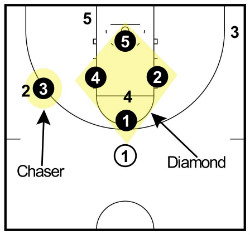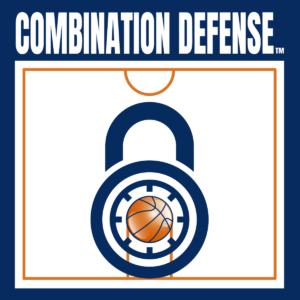Developing basketball defensive systems stands as one of the most important aspects for any coach out there. While designing offensive plays might be more fun, crafting the right defensive system might make more a difference between winning and losing. A good defense feeds directly into offense and it makes scoring that much easier. Basketball coaches implementing combination defenses, like the Diamond and 1 defense, can make things even more difficult for opponents.
Many coaches believe it’s better to sport a simple offense and complex defense, rather than the other way around. How a coach crafts their team’s defensive approach often dictates the very identity of the team. Also, not all players, particularly at the youth level, will have the same natural abilities on the offensive end, but most players can be taught complex defensive schemes and excel.
What is the Diamond and 1 Defense?
The Diamond and 1 defense stands as a variation of the classic Box and 1 defense. This defensive strategy seeks to limit the scoring opportunities of your opponent’s best player. This is accomplished by installing a combination defense that relies on both man-to-man and zone principles.
A Diamond and 1 takes your team’s best defender and tasks him with disrupting the playmaking opportunities of your opponent’s top perimeter scorer. At the same time, the additional four defenders will play a zone in the form of a diamond, hence “diamond and 1.” This formation provides better protection around the perimeter than the Box and 1 because there will be three defenders in coverage rather than two. However, it provides less help on the backline and can leave the corners susceptible to attack.
Implementing the Diamond and 1 Defense
 The Diamond and 1 defense aligns in a similar fashion to the Triangle and 2 defense, but instead of using two chasers, it only uses one.
The Diamond and 1 defense aligns in a similar fashion to the Triangle and 2 defense, but instead of using two chasers, it only uses one.
The chaser in this defensive setup can pickup their mark either full court or once that player has crossed half court. This defense typically employs a ball-denial approach, with the chaser shadowing their mark throughout a given possession.
The other defenders use zone defense principles to guard in the half court. One player takes the top of the key, while two others take the elbow areas. The final defender stands in the lane as the rim protector. The elbow defenders are responsible for the wings, while the backline defender takes the low blocks and short corners.
This defensive set up requires excellent athleticism and anticipation on the part of the chaser, while emphasizing communication and rotation for the zone defenders. This defense is more useful than the Box and 1 when facing an opponent with skilled perimeter shooters. However, there is a weakness in the high-post area. The Diamond and 1 half court defense is different than the Diamond and 1 full court press or half court trap.
Points of emphasis for this defense include securing the rebound to limit second-chance opportunities, and collapsing to the middle when star players touch the ball. The zone defenders must be in position to both rebound and provide help when necessary.
Learn the Combination Defense to beat the BEST team on your Schedule!
Go to COMBINATIONDEFENSE.com now for all your coaching needs.
This innovation defensive coaching lesson includes everything a coach needs to implement these game-changing strategies.
Among the combo defenses dissected in this lesson are the Box and 1, the Triangle and 2, the Diamond and 1.
Content includes:
- Engaging Video Lessons
- Drills and Implementation Practices
- Q & A
- Bonus sections features – Offenses vs Combo Defenses, Tracking and Possession Charts
Related: 3 Great Defensive Drills to Improve Help and Rotation
Resource:
The Coach Unplugged Podcast

Ep 1406 Office Hours and Combination Defenses
If you found this useful, don’t forget to check out additional blog posts at TeachHoops.com. Also, check out TeachHoops on Facebook, Twitter, Instagram and YouTube.



